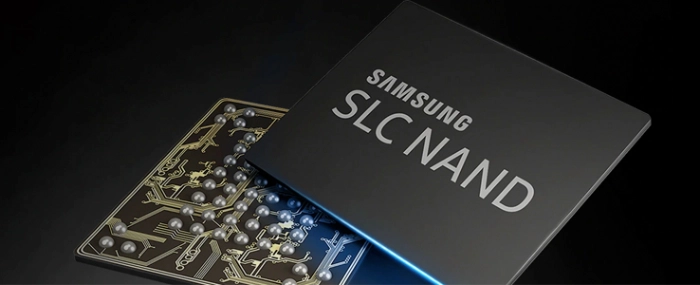
Total NAND Flash revenue drops 2.1% QoQ in 4Q21
In 4Q21, NAND Flash bit shipments grew by only 3.3% QoQ, a significant decrease from the nearly 10% in 3Q21, according to TrendForce’s investigations.
ASP fell by nearly 5% and the overall industry posted revenue of USD 18.5 billion, a QoQ decrease of 2.1%. This was primarily due to a decline in the purchase demand of various products and a market shift to oversupply causing a drop in contract prices. In 4Q21, with the exception of enterprise SSD, the supply of which was limited by insufficient upstream components, the prices of other NAND Flash products such as eMMC, UFS, and client SSD, all fell.
TrendForce’s summary of NAND Flash market sales performance in 2021 is as follows: although there have been signs of weakening since 2H21, thanks to remote services and cloud demand driven by the pandemic, revenue performance still grew significantly compared to 2020. Revenue reached USD 68.6 billion, up 21.1% YoY, the second-biggest increase since 2018.
NAND Flash revenue fell for most manufactures in 4Q21 due to PC OEM destocking
There were some changes to the top three NAND Flash revenue rankings in 4Q21 compared 3Q21, Samsung and Kioxia remained in the top two while third place was replaced by Western Digital (WDC). Although there was still demand coming from data centers, as PC OEMs continued to deplete client SSD inventories and demand from China's smartphone market weakened, stocking momentum was affected by component mismatch issues, resulting in a decline of approximately 5% in Samsung Electronics' bit shipments in 4Q21. After the market shifted to oversupply, ASP also fell by approximately 5%, leading to Samsung Electronics posting 4Q21 revenue of USD 6.110 billion, a QoQ decrease of 6.1%.
Second ranked Kioxia continued seeing strong demand from data center clients in 4Q21 but this was offset by inventory adjustment and reduced purchasing on the part of PC OEMs. Bit shipments declined slightly by 1% and ASP remained flat even in the face of weakening market demand, which was better performance than that of other suppliers in the same period. Revenue in 4Q21 reached USD 3.543 billion, a QoQ decrease of 2.6%.
WDC was another company that benefited from continued strong stocking demand from major US smartphone clients for new 5G flagship phones which offset the impact of weak client and enterprise SSD sales, for bit shipment growth of 13%. However, as the proportion of consumer goods grew, ASP declined by 6%. WDC’s NAND Flash division posted 4Q21 revenue of USD 2.62 billion, a QoQ increase of 5.2%.
Benefiting from continued stocking from data center clients and US-based smartphone brands, SK hynix's bit shipment growth remained above 10%, in line with original forecasts. However, ASP was affected by weaker mobile phone shipments in China and inventory adjustment at PC OEMs. Pricing fell by nearly 10% which offset overall growth momentum. Revenue posted by SK hynix's NAND Flash division in 4Q21 increased by 2.8% to USD 2.615 billion.
Micron was similarly affected by inventory adjustments undertaken on the part of PC OEMs and data center clients. Although Micron's 176-layer products continue to be adopted, shipments in 4Q21 were flat compared to 3Q21 and ASP fell approximately 5% as the growth rate of supply outpaced demand, leading to a decline of 4.7% in Micron's 4Q21 NAND Flash revenue to USD 1.878 billion.
Solidigm's 4Q21 production capacity was still being affected by the impact of supply chains (such as PMIC supply) on enterprise SSD, resulting in a continued decline in bit shipments of nearly 5% in 4Q21. At the same time, while orders for laptops are still strong, Solidigm actively increased bits shipments of PC QLC SSDs in order to reduce production capacity, causing a drop in ASP and a 4Q21 NAND Flash revenue performance of only USD 996 million, a 9.9% decline.
Looking forward to 1Q22, TrendForce states that with the advent of the demand off-season, demand for major applications will show a seasonal decline, exacerbating the phenomenon of oversupply and driving the contract price of products to fall further. Falling prices and shrinking volume is expected to further reduce the revenue level of the NAND Flash industry. Referencing information released by TrendForce on Feb. 10, it is worth noting that market expectant psychological factors in 2Q22 generated from the previous Kioxia and WDC raw material pollution incidents will change the supply and demand situation after February and certain products with additional orders and non-quarterly contract prices will immediately reflect a pricing increase. This will help reduce the decline in the output value of NAND Flash in 1Q22.
| Company | Revenue | Market Share | ||
| 4Q21 | QoQ (%) | 4Q21 | 3Q21 | |
| Samsung Electronics | 6,110.0 | -6.1% | 33.1% | 34-5% |
| Kioxia | 3,543.6 | -2.6% | 19.2% | 19.3% |
| WDC | 2,620.0 | 5.2% | 14.2% | 13.2% |
| SK hynix | 2,615.0 | 2.8% | 14.1% | 13.5% |
| Micron | 1,878.0 | -4.7% | 10.2% | 10.4% |
| Solidigm | 996.0 | -9.9% | 5.4% | 5.9% |
| Others | 718.4 | 15.8% | 3.9% | 3.3% |
| Total | 18,480.9 | -2.1% | 100.0% | 100.0% |
